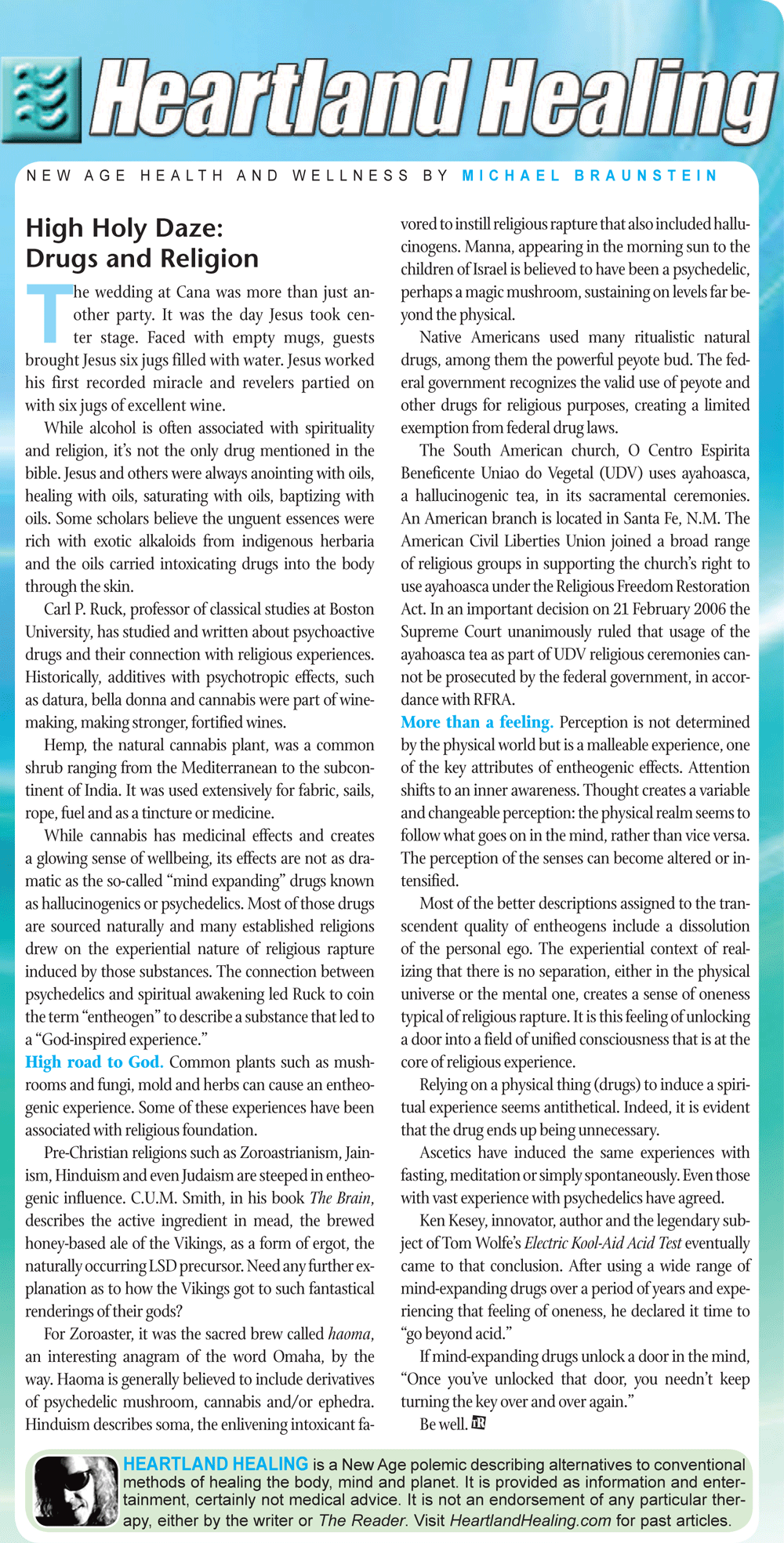|
||||||
| Back to Column Archives | ||||||
HIGH HOLY DAZE: DRUGS AND RELIGION The wedding at Cana was more than just another party. It was the day Jesus took center stage. Faced with empty mugs, guests brought Jesus six jugs filled with water. Jesus worked his first recorded miracle and revelers partied on with six jugs of excellent wine. While alcohol is often associated with spirituality and religion, it’s not the only drug mentioned in the bible. Jesus and others were always anointing with oils, healing with oils, saturating with oils, baptizing with oils. Some scholars believe the unguent essences were rich with exotic alkaloids from indigenous herbaria and the oils carried intoxicating drugs into the body through the skin. Carl P. Ruck, professor of classical studies at Boston University, has studied and written about psychoactive drugs and their connection with religious experiences. Historically, additives with psychotropic effects, such as datura, bella donna and cannabis were part of wine- making, making stronger, fortified wines. Hemp, the natural cannabis plant, was a common shrub ranging from the Mediterranean to the subcontinent of India. It was used extensively for fabric, sails, rope, fuel and as a tincture or medicine. While cannabis has medicinal effects and creates a glowing sense of wellbeing, its effects are not as dramatic as the so-called “mind expanding” drugs known as hallucinogenics or psychedelics. Most of those drugs are sourced naturally and many established religions drew on the experiential nature of religious rapture induced by those substances. The connection between psychedelics and spiritual awakening led Ruck to coin the term “entheogen” to describe a substance that led to a “God-inspired experience.” Pre-Christian religions such as Zoroastrianism, Jainism, Hinduism and even Judaism are steeped in entheo- genic influence. C.U.M. Smith, in his book The Brain, describes the active ingredient in mead, the brewed honey-based ale of the Vikings, as a form of ergot, the naturally occurring LSD precursor. Need any further ex- planation as to how the Vikings got to such fantastical renderings of their gods? For Zoroaster, it was the sacred brew called haoma, an interesting anagram of the word Omaha, by the way. Haoma is generally believed to include derivatives of psychedelic mushroom, cannabis and/or ephedra. Hinduism describes soma, the enlivening intoxicant favored to instill religious rapture that also included hallu- cinogens. Manna, appearing in the morning sun to the children of Israel is believed to have been a psychedelic, perhaps a magic mushroom, sustaining on levels far be- yond the physical. Native Americans used many ritualistic natural drugs, among them the powerful peyote bud. The federal government recognizes the valid use of peyote and other drugs for religious purposes, creating a limited exemption from federal drug laws. The South American church, O Centro Espirita Beneficente Uniao do Vegetal (UDV) uses ayahoasca, a hallucinogenic tea, in its sacramental ceremonies. An American branch is located in Santa Fe, N.M. The American Civil Liberties Union joined a broad range of religious groups in supporting the church’s right to use ayahoasca under the Religious Freedom Restoration Act. In an important decision on 21 February 2006 the Supreme Court unanimously ruled that usage of the ayahoasca tea as part of UDV religious ceremonies can- not be prosecuted by the federal government, in accor- dance with RFRA. More than a feeling. Perception is not determined by the physical world but is a malleable experience, one of the key attributes of entheogenic effects. Attention shifts to an inner awareness. Thought creates a variable and changeable perception: the physical realm seems to follow what goes on in the mind, rather than vice versa. The perception of the senses can become altered or intensified. Most of the better descriptions assigned to the transcendent quality of entheogens include a dissolution of the personal ego. The experiential context of real- izing that there is no separation, either in the physical universe or the mental one, creates a sense of oneness typical of religious rapture. It is this feeling of unlocking a door into a field of unified consciousness that is at the core of religious experience. Relying on a physical thing (drugs) to induce a spiri- tual experience seems antithetical. Indeed, it is evident that the drug ends up being unnecessary. Ascetics have induced the same experiences with fasting, meditation or simply spontaneously. Even those with vast experience with psychedelics have agreed. Ken Kesey, innovator, author and the legendary subject of Tom Wolfe’s Electric Kool-Aid Acid Test eventually came to that conclusion. After using a wide range of mind-expanding drugs over a period of years and experiencing that feeling of oneness, he declared it time to “go beyond acid.” If mind-expanding drugs unlock a door in the mind, “Once you’ve unlocked that door, you needn’t keep turning the key over and over again.”
|
||||||
|
home • directory • feature column • column archives • news • hot links • calendar
Heartland Healing is devoted to the examination of various alternative forms of healing. It is provided as a source of information and not as medical advice. It is not meant as an endorsement of any particular therapy, either by the writer or by Heartland Healing Center, Inc. © 1997- Heartland Healing All Rights Reserved • Site by Omaha's Desktop Ad Shop |




